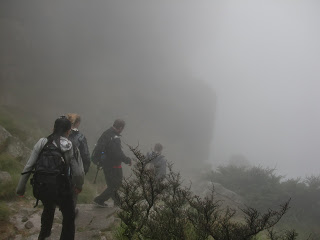Just to prove that I'm actually moderately accomplished, I've posted the very incomplete text of my first article!
So read it. Enjoy it.
Know that it's not done yet but still, it's on its way.
(insert clever yet serious title)
(insert clever subheading about rising from the ashes of a fire...phoenix....something)
A pile of charred wood is all that’s left of the shacks. The sand where they sat is littered with burned belongings: a blackened Bible, an office chair, clothes no longer usable. The metal sheets that had once been walls have been salvaged, taken for use in new shacks, the obviously burnt edges blending in amongst the rust.
The first fire broke out three weeks before in the same shack that would be the ignition point of the second fire, which would tear through the informal settlement of Village Heights in Cape Town, depriving fifteen families of their homes.
Fires in informal settlements like Village Heights represent one of the biggest dangers of living in such a community. Even with attempts to build with space on all sides, fires such as the one that destroyed fifteen shacks can spread quickly since the materials used to construct the homes are highly flammable and unregulated.
“It was better under apartheid,” says Bernie, the community leader who has created and maintained the Village Heights library, and who is the recipient of the first Projects Abroad sandbag house in South Africa. “At least then we all had our own homes and jobs. Now we have nothing.”
According to residents, after the first fire the government offered four wooden posts, five pieces of metal and some grounding plastic as a replacement. However, the metal went to the construction of a roof and the residents were left to use plastic to create walls. During the second fire, a woman was badly burned when the plastic melted onto her skin.
Proper housing is something that many people living in South Africa lack, for a multitude of reasons. “I’ve been on a waiting list for twenty one years,” says one woman who lost her home in the fire. “My daughter’s twenty now.”
While debates rage about governmental involvement and personal contribution for houses, the issue remains that people lack proper living quarters. Residents of the informal settlements around Cape Town and throughout South Africa are forced to create homes using materials that they can find, salvage, or buy, resulting in homes that often lack even basic features such as a floor. Security measures are an afterthought, allowing for criminal activity to flourish in the neighborhoods.
Sand is nearly ubiquitous in Cape Town and the surrounding areas, and it might present a feasible solution to the problem of the shack homes in the ever-expanding informal settlements. Filling bags with sand and then stacking them within a frame can create a solid structure that is built both efficiently and quickly.
Beginning with materials, construction with sandbags can be a cheap alternative to traditional building methods. Since all that is needed to build a sandbag structure are bags, sand, cement and a wood and metal frame, the cost drops significantly due to the lack of construction equipment needed. No cranes, no stacks of bricks and no heavy vehicles entering or leaving the construction site.
This cost effective creation is also eco-friendly. Since most of the building can be done with materials found on-site, the need for waste is nearly eliminated. This waste elimination plays a large factor in the eco-friendly nature of the sandbag buildings.
Builders who choose to use sandbag building as an alternative to conventional construction methods also stand to gain carbon credits for their choices. Carbon credits programs offer financial incentives for companies to build in keeping with the “green” trends and for waste elimination and recycling of materials.
This waste elimination and recycling presents an opportunity for those who are economically disadvantaged. By being able to build effectively and also save money, they can increase community bonds and safety.
Besides being fireproof, the sand structures also present an element of soundproofing not found in the corrugated iron structures, which currently make up most of the homes in the townships and informal settlements in the Cape Town area.
They are also not easy to deconstruct or demolish, in essence creating a lasting home that won’t be victim to natural disasters such as flooding or tornadoes.
The solidity of the sand as it is packed and stacked neatly to create walls allows for an element of indoor climate control that supersedes that provided by the corrugated structures as well. The sand essentially insulates the home, keeping it warmer in the winter and cooler in the summer.
The surmountable caveat to sand building is that it is not well known. The newly homeless fire victims had never heard of sandbag building when asked about it yet were curious as to how it might work. They eagerly agreed that the community would want to be involved in such building, given the right materials.
Based on the readily available materials and the community mentality that many of the neighbourhoods have, it seems that if sandbag structures could catch on, they might make a wonderful improvement for communities who are underfunded and under protected.
Projects Abroad began constructing their sandbag house at the site of the Village Heights Library in August of 2010. While normally the construction of such a building (one room) would take less than a month, due to staggered volunteer arrivals, the project has continued for more than three months. However, the house is beginning to take shape.
The project supervisor, Deen Singh remains optimistic that the sandbag building will be used for the betterment of the community. He explained that everything must be done to help the children.
....
it will go on.



























